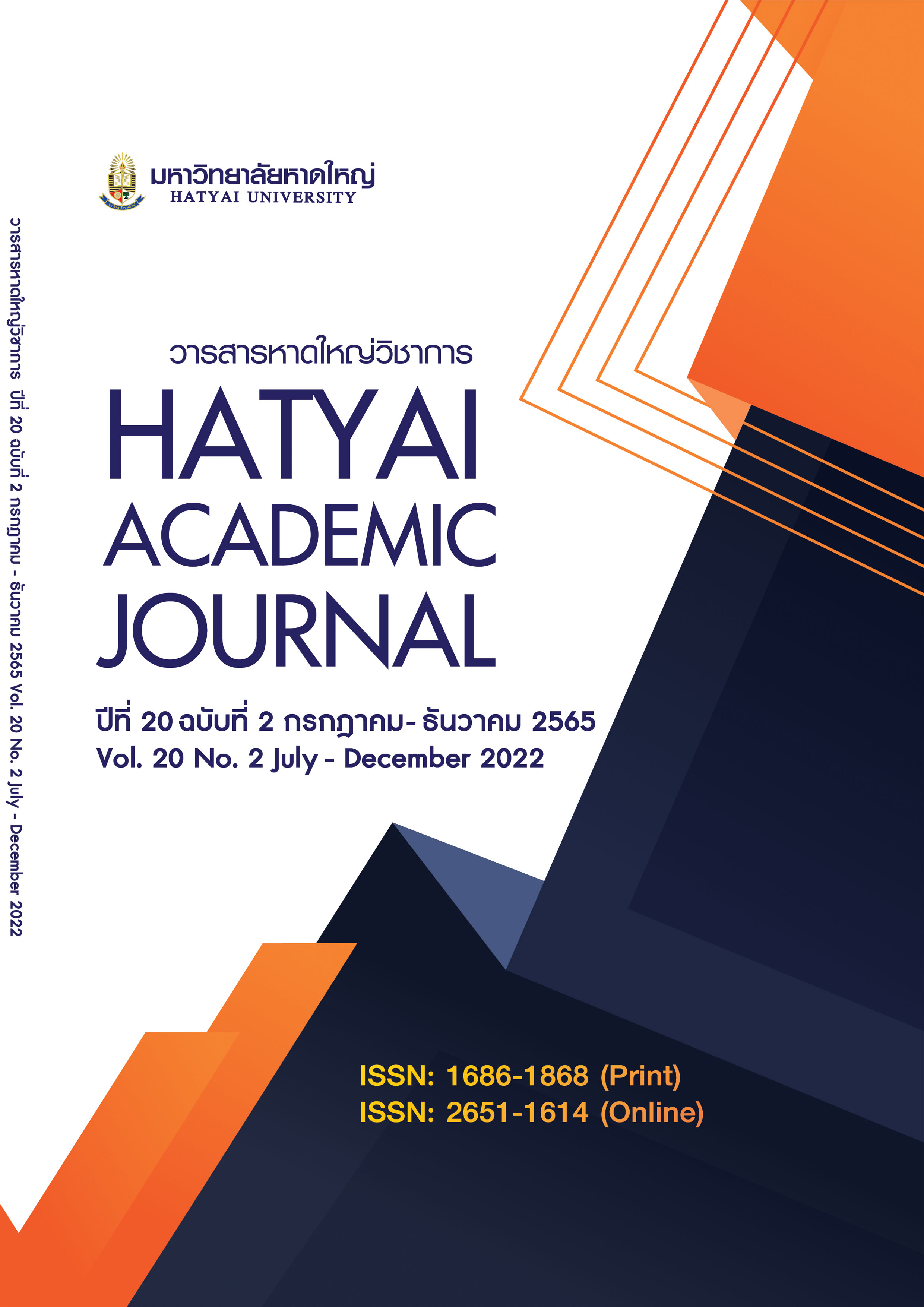A Temple’s Management of Buddhist Artworks for Promoting Thailand and Malaysia Border Tourism: A Case Study of Wat Phutthathiwas, Betong, Yala Province
Main Article Content
Abstract
The objectives of this qualitative study were to study the physical appearance of Buddhist artworks and construction at Wat Phutthathiwas’ and the temple’s management of these attractions to promote tourism at the Thailand-Malaysia border. Data were collected from related documents and the field study through non-participant observation and in-depth interviews of 17 informants. The informants were selected using purposive sampling, and consisted of Buddhist monks, locals, academics, and tourists. The data were validated using triangulation and later descriptively concluded. The study found that the temple arranged the landscape where the constructions are located with pagodas, monk’s dwellings, pavilions, Buddha images, roads, and a crematorium in seven descending order to mean the seven noble treasures in a sacred place. The following are the temple’s management of Buddhist artworks: 1) Planning: The temple focuses on developing people rather than the constructions. This is because when people are developed, they will be aware of the value of Buddhist artworks and behavioral adaptation. 2) Organizational structure consists of administration, Dhamma dissemination, education, buildings and grounds, and others. The buildings and grounds department is directly responsible for Buddhist art preservation for tourism promotion. 3) Command and control: The temple exercises its power not through authorization but by request. People are requested to preserve the arts and learn about their benefits and value for tourism. 4) Coordination: Communication of both insiders and outsiders including networking is based on the temple’s monks trustworthiness.
Article Details

This work is licensed under a Creative Commons Attribution-NonCommercial-NoDerivatives 4.0 International License.
All published articles are evaluated by three qualified peer reviewers from various institutions through a double-blind process, where reviewers do not know the authors’ identities and authors do not know the reviewers’ identities. The content and articles in the Hatyai Academic Journal reflect the authors’ views only and are neither the opinions of the editorial board nor the responsibility of Hatyai University. The Editorial Board of the Hatyai Academic Journal allows articles to be reproduced for academic purposes, on the condition that the original source is clearly cited.
References
Bhudhisaro, R. (2016) The concept of travel resource management (temple) in Buddhism: Theory, principles and practices. Retrieved from http://gps.mcu.ac.th/wpcontent/uploads/2016/09/Buddhist-Tour-Management.pdf [in Thai]
Foundation for Pramahathatchediphakdeeprakas. (n.d). Pramahathatchediphraputtatham prakas. Bangkok: Amarinprinting and Publishing. [in Thai]
Jeeratasnakun, S. (2002). Temple: Buddhist and Thai architecture. Bangkok: Kledthai. [in Thai]
Jeerawit, Fake name. (2015, January 25). Tourist (interview). [in Thai]
Klinchan, N., Suyajai, P., & Thachatammo, P. (2009). The important religious sanctuary to ward ecotourism of temples in Bangkok (Research report). Phra Nakhon Si Ayutthaya: Mahachulalongkornrajavidyalaya University. [in Thai]
Kongkham, T. (2019). Betong bustle with Malaysian, Singapore tourists, until full hotel bookings during the new year. Retrieved from https://www.thaipost.net/ [in Thai]
Kruthniyom, T. (1998). History of Phutthattiwas, Betong, Yala Province. Bangkok: Sahathammic Printing House. [in Thai]
Kruthniyom, T. (2015, January 25). Acedamic (interview). [in Thai]
Kullayanamit, C. (1982) Thai aspects. Bangkok: Thaiwattapanich. [in Thai]
Kumdee, K. (2015). Temples and religion place in tourism dimension. Journal of Graduate Study in Humanities and Social Science, 4(2), 175-191. [in Thai]
Mani, Fake name. (2015, March 16). Tourist (interview). [in Thai]
Marnit, Fake name. (2015, March 16). Tourist (interview). [in Thai]
Nagavaro, P., Suthiwirabandit, P., & Thongin, T. (2017). Good management model of monastery in Chainat Province. Journal of MCU Social Sciences Review, 6(4), 141-153. [in Thai]
National News Bureau of Thailand. (2015). “Betong” tourism model city. Retrieved from http://thainews.prd.go.th/th/news/detail/TCATG200226121614070 [in Thai]
Nokkaew, C. (2016). Tell story “Betong” with old images. Yala: Yala Printing. [in Thai]
Piyakoon, C. (2018). Go back to dead sites of Luang phor thuat who tread fresh water. Retrieved from https://www.komchadluek.net/news/knowledge/222286 [in Thai]
Poshyanandana, V. (2015). Landscape and architecture management of Thai temples for faith fostering: Past to present (Research report). Bangkok: Chulalongkorn University. [in Thai]
Prahaung, Fake name. (2015, May 27). Monk (interview). [in Thai]
Prakrupaisarnwitthikid. (2015, March 15). Monk (interview). [in Thai]
Prakruwisutthiselapiwath. (2015) The temples development model toward tourism place culture integration. Journal of MCU Humanities. Sciences Review, 1(20), 65-74. [in Thai]
Prasarn, Fake name. (2015, March 15). Monk (interview). [in Thai]
Prayongyuth, Fake name. (2015, March 15). Monk (interview). [in Thai]
Prom, Fake name. (2015, March 14). Villager (interview). [in Thai]
Saksri, N., & Thaphatthee, W. (1996). Royal craftsmen Thai architecture works of Mittrarun Kasemsri. Bangkok: Bangkok Printing House. [in Thai]
Santhiwong, T. (1997). Organization and administration (11th ed.). Bangkok: Thaiwatthanapanich. [in Thai]
Sukmitree, J. (2018). Coordination techniques in organizations. Prae-wa Kalasin Journal of Kalasin University, 5(2), 263-276. [in Thai]
Tawinwong, K. (2016). Tourism management for cultural preservation and highlighting Buddhism through temple stay retreats in and around Wat Phuket, Northern Thailand (Master’s thesis). Thammasat University, Bangkok. [in Thai]
Tepsing, P., & Boonprakarn, K. (2019). Buddhist temple management for religious tourism: A case study of Tham Khao Roop Chang temple, Songkhla Province, Thailand. Kasetsart Journal of Social Sciences, 40(2), 472-479. [in Thai]
Wat Phutthattiwas (2015). Record of Buddha image creation (tablet). Betong, Yala Province. [in Thai]

